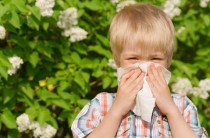Allergies are becoming more and more common in today's world. Of course, descriptions of this disease were found in the writings of Hippocrates and Avicena, who lived long before us. However, in those distant times of natural food, cosmetics and hygiene products, as well as fresh air, subsistence farming and the absence of industry, it was perceived as something outlandish. Alas, modern man takes allergies for granted. Indeed, in any case, if not himself, then one of his relatives or friends suffers from allergic diseases.
And one of the most common manifestations of allergies is a disease called "polinosis". Polynosis is a complex of allergic reactions that develop by our body in response to the ingress of a specific allergen, which is, in this case, plant pollen. If we talk about ordinary plants that grow in our country, then their pollen is not harmful to the human body. However, the immunity of an allergic person perceives this substance as a potential enemy.
This means that the body will fight with it, as with a parasite that has got inside. He will try to bring it out along with mucous secretions, so an allergic person begins to have an increased discharge from the nasal cavity, tearing, sneezing and a dry, allergic cough. He will also raise the temperature to create unfavorable conditions for the life of uninvited guests. As we can see, all allergy symptoms come from the fact that the body has a pathological sensitivity to safe substances. The reason for this lies in violations of the normal functioning of the immune system. Moreover, the more developed the country, the more the population suffers from allergies.
Residents of developed countries experience the inevitable influence of harmful substances of an industrial nature, are constantly annoyed by a large amount of incoming information and noise, use a lot of cosmetics and household chemicals, use a lot of non-natural products, etc. All this introduces disharmony into the normal functioning of the human immune system, which serves as a trigger for triggering allergies. A very eloquent fact testifies in favor of this: people living in the countries of the 3rd world, as well as in deep villages and villages, are many times less susceptible to this disease than those who live in large metropolitan areas. It becomes obvious that the blame for everything is the way of life of modern man.
Allergy to flowering, symptoms
Allergy to pollen is manifested by a very diverse symptomatology. Some symptoms are practically not troublesome, but there are those that directly threaten the life of the patient. That is why, even a mild form of pollen allergy must be stopped, because it can happen that if pollen is abundantly ingested, allergy symptoms will be replaced by extremely severe manifestations.
The most common symptoms of a pollen allergy include:
Allergic rhinitis.
This is a general group of allergy manifestations that affect the nasopharynx: nasal congestion caused by vasodilation; increased secretion of nasal mucus of a transparent color; frequent sneezing; difficulty breathing; Allergic conjunctivitis.
Like rhinitis, it is rather a group of symptoms according to localization. This group of symptoms affects the organs of vision: redness of the eyes, tearing, increased sensitivity to light, discomfort, crusting in the eyelids, redness of the area around the eyes, itching and irritation. Asthmatic symptoms.
In acute forms of allergy, asthmatic symptoms may manifest, characterized by an attack of suffocation, difficulty breathing, wheezing, coughing. In this case, they talk about asthma of an allergic nature. Increased body temperature, general weakness, headache.
The symptoms of feeling unwell, especially at first, are very similar to viral infections, so the patient is often confused, especially when he encounters allergic reactions for the first time. Skin manifestations, characterized by the appearance of red spots, vesicles and blisters, which, when combed, form a yellow-brown crust, peeling, changes in the texture of the skin, itching, irritation.
Flower allergy. Complications
A special conversation should be about such manifestations of allergic reactions as angioedema and anaphylactic shock. This group of symptoms is a potentially life-threatening symptom and can manifest itself at the most inopportune moment, including pollen allergy.
Angioedema is a sudden onset of tissue edema that occurs in response to an allergen in a patient with hypersensitive immunity, or with a large amount of the allergen. This type of edema can cover a significant part of the tissues: lips, facial skin, groin, etc., but it poses the greatest danger when it develops within the soft tissues of the larynx. In this case, the patient begins to suffocate due to the blockage of the airways. This condition requires urgent therapeutic measures, in which adrenaline injections, corticosteroids, antihistamines are used. Moreover, all this is used in large quantities, many times higher than the usual therapeutic dosages.
Anaphylactic shock is a critical manifestation of an allergic reaction, in which there is a reflex contraction of the muscles of the larynx, swelling of the tissues of the larynx and bronchospasm. This makes breathing critically difficult, which can lead to a critical lack of oxygen and, as a result, death. The general characteristics of emergency procedures are the same as for angioedema, with their own specification.
In view of the development of severe manifestations upon contact with the allergen, diagnostic measures are carried out only in a medical hospital. The doctor necessarily acquaints with the risk of complications, as well as with measures against severe complications. For this reason, tests based on the patient's contact with the allergen are not carried out during periods of manifestations of pollen allergy.
Flower allergy pills
With an allergy to pollen, the use of tablets has several advantages:
ease of use: pills for allergies to flowering are easy enough to take with clean hands and swallow with a sufficient amount of liquid.
there is no risk of infection when injecting.
Antihistamines
Antihistamines are allergy medications that work by displacing histamine when in contact with allergic-sensitive cells. This property of histamine blockers allows you to interrupt the allergic reaction, which prevents the development of allergy symptoms. The first antihistamines, such as demidrol or diazolin, had a significant degree of side effects, while modern drugs do not have significant side effects and are suitable for use even in children and the elderly.
Special care should be taken when taking antihistamines for pregnant and lactating women, since most antihistamines have a pronounced effect on the fetus, and can also disrupt the course of pregnancy.
Tavegil is the most popular remedy for pollen allergies. The active substance (clemastine) is easily absorbed from the gastrointestinal tract and penetrates into the bloodstream, having a noticeable effect on relieving allergy symptoms after 5-6 hours. The active substance is more effective in relieving the symptoms of allergenic rhinitis and dermatitis - the main symptoms of pollen allergy.
Tavegil is contraindicated in breastfeeding, the use of monoamine oxidase inhibitors, as well as under the age of 1 year.
Diazolin : First generation anti-allergy drug. The active substance mebhydrolin has a pronounced effect on the symptoms of allergic manifestations. However, it has a pronounced inhibitory effect on the central nervous system, resulting in fatigue, drowsiness and lethargy. Diazolin also has an effect on histamine receptors in the gastrointestinal tract, which provokes an increase in acidity and irritation of the mucous membrane. It is not used for exacerbations of peptic ulcers, and given the large selection of modern drugs, it is better to avoid taking it even during remission.
Diazolin is an outdated drug whose only advantage is low cost compared to second and third generation drugs.
Erius is a modern drug that has minimal side effects. Active ingredient: desloratidin affects only allergy receptors, due to which it does not have such side effects as: diarrhea, dryness of the mucous membranes of the mouth and nose, heart palpitations. Desloratidin has no inhibitory effect, due to the fact that it does not penetrate the brain.
Desloratidine binds to histamine receptors for a long time. It is enough to take 1 tablet (5mg) once a day for the effect to develop for 12 hours. The effect of Erius on the body of a pregnant woman has not yet been identified, however, desloratidin penetrates into breast milk, therefore it is contraindicated during breastfeeding.
Suprastin is an effective remedy for removing skin manifestations of allergies and rhinological manifestations, which makes it highly effective in hay fever (pollen allergy). Its use is justified in cases where side effects need to be eliminated quickly. Effectively relieves exacerbations in pollen allergies. The active substance begins activity to relieve allergy symptoms in the first 20-30 minutes after ingestion.
Diphenhydramine is one of the earliest antihistamines. It has a significant range of side effects, due to the non-selectivity of the active substance in relation to histamine H1 receptors. It affects other receptor systems of our body, and also easily penetrates the brain, resulting in the development of such side effects: CNS inhibition, tachycardia, constipation, dry mouth, has a strong hypnotic and muscle relaxant effect. In general, a very inconvenient drug in terms of the development of side effects, which has the only advantage - low cost, compared with second and third generation drugs. In no case should the drug be combined with alcohol, as this can cause severe mental disorders.
Azelastine is another effective remedy for allergic rhinitis and dermatological manifestations. Azelastine can cause drowsiness, as well as problems with appetite, so it is not recommended for people who are underweight.















